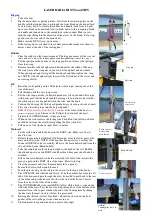
4
frequency
shifting
havior in the "Negative Frequencies?" section).
The functions of these two pairs effectively
swap when the shift knob is turned to the left
of 0Hz, or a negative control voltage is applied.
Two ±5V range CV inputs are available for
modulating the amount of frequency shift:
exp fm
7
for exponential control and lin
tz fm
8
for linear control. The sensitivity
of the exponential input is switched together
with the range switch, while the sensitivity
of the linear input is controlled by the atten-
uator
9
and doesn’t change with range.
Koszalin provides several internal feedback
options. The regen switch
10
determines
internal feedback routing: from downshifted
signals, upshifted signals, or both combined
(combo feedback explained below). The
feedback amount is controlled with the re-
gen knob
11
, and CV plugged into the corre-
sponding jack
12
. The temporal character of
the feedback effect depends on the density
parameter, controlled by knob
13
and/or CV
via the corresponding input below
14
.
WhAt IS freQueNcY ShIftING?
Frequency shifting is a process that affects all
spectral components of a signal by changing
their frequencies by an equal number of Hz.
For example: if the input is a periodic wave-
form with a 1kHz frequency, it usually con-
tains the 1kHz component plus the harmonic
overtones: 2kHz, 3kHz, 4kHz, etc. When this
signal is shifted by 200Hz the result contains
1.2kHz, 2.2kHz, 3.2kHz, 4.2kHz, etc. (fig. 2).
That means the new components are no lon-
ger multiples of the first frequency; hence the
signal is inharmonic and non-periodic.
Bear in mind that this is a very different ef-
fect to pitch shifting, which results in scaling
the frequencies by the same factor. So, for
example, applying a factor of 1.2 would re-
sult in a signal that contains 1.2kHz, 2.4kHz,
3.6kHz, 4.8kHz, etc.—still a harmonic signal,
just with a different pitch.
Technically, shifting of the spectrum is achieved
through Single Side Band (SSB) modulation
that is much more complex than a simple mul-
tiplication, which is sometimes inappropriately
called ring modulation.
A common fallacy says modulation is the same
as adding and subtracting signals, which is
nonsense since multiplying is not adding and
subtracting. Instead, this type of modulation
(specifically, four quadrant amplitude mod-
ulation) affects individual harmonic compo-
nents in such a way that their frequencies are
added and subtracted.
The SSB separates these modulation products
and offers two new signals: one with frequen-
cies shifted up and one with frequencies shift-
ed down. This is obtained by complex filtering,
phase rotation, and quadrature modulations,
which are difficult to achieve with analog
technology but relatively easy with DSP.
note:
summing both down- and upshifted signals
reduces the effect to a mere multiplication
(balanced modulation, aka “ring mod”).


























